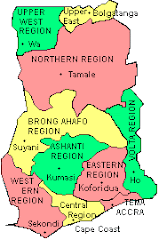I spent another day of farmer group meetings with an AEA named Margret aka Maggie - the only female AEA I’m working with. On our way to meet with the group we passed the 2nd largest man-made dam in
The Agriculture as a Business (AAB) program that I’m implementing with Mofa focuses on AEA’s encouraging and supporting farmers to manage their farms as a profitable business, not just for subsistence, or farming because that’s all you know how to do, or because your parents were farmers. One of the aims of AAB is to end up with farmers who feel proud to run their profitable farming business and earning more income therefore improving their standards of living. At first I was a little skeptical of AAB with its profit and monetary focus, but at the end of the day if you ask a farmer if she or he would like to make more money, I’m positive they will say yes. And with high poverty rates around here it makes sense.
There are 8 areas we’re focusing on: group strengths, group meetings, finances, group project, business plan, record keeping, group marketing, and evaluation. They are in the format of laminated cards with pictures and sometimes stories of other farmer groups on the front and steps/directions on the back to help the AEA have discussions and ask questions with the farmers. Here’s an example from the finances card:
step1: ask the group what is the meaning of the picture? Step 2: ask the group how we can improve group finances? What is the group’s plan for their savings? Does the group keep financial records? The card also provides more questions to help the AEA facilitate a discussion on group finances. The approach is to talk with farmer groups and encourage them to make their own decisions on how they can improve, while supporting and helping them in their decisions. For instances, in this case the card also says ask the group what plan they want to make and encourages them to record it. Essentially the AAB cards are a tool to help improve the service AEA’s provide to farmers, and to discuss and encourage rather than dictate information to farmers. The more tangible aspects of AAB are encouraging farmers to keep records and make a business plan while talking with them about if they already have or have not and why. A less tangible aspect would be talking about group meetings and discussing the importance of strong meetings.
I think it’s important to note that the majority of farmers in the Upper East and all the farmers we work with are locally producing and small scale, that is, not overseas exporting and using large acreages with heavy equipment like tractors and combines (but some groups are able to contract tractor services to plow their fields, others rent bull-plow services, and many prepare their land by hand tools). Few individuals own more than 5 acres of land around here.






No comments:
Post a Comment